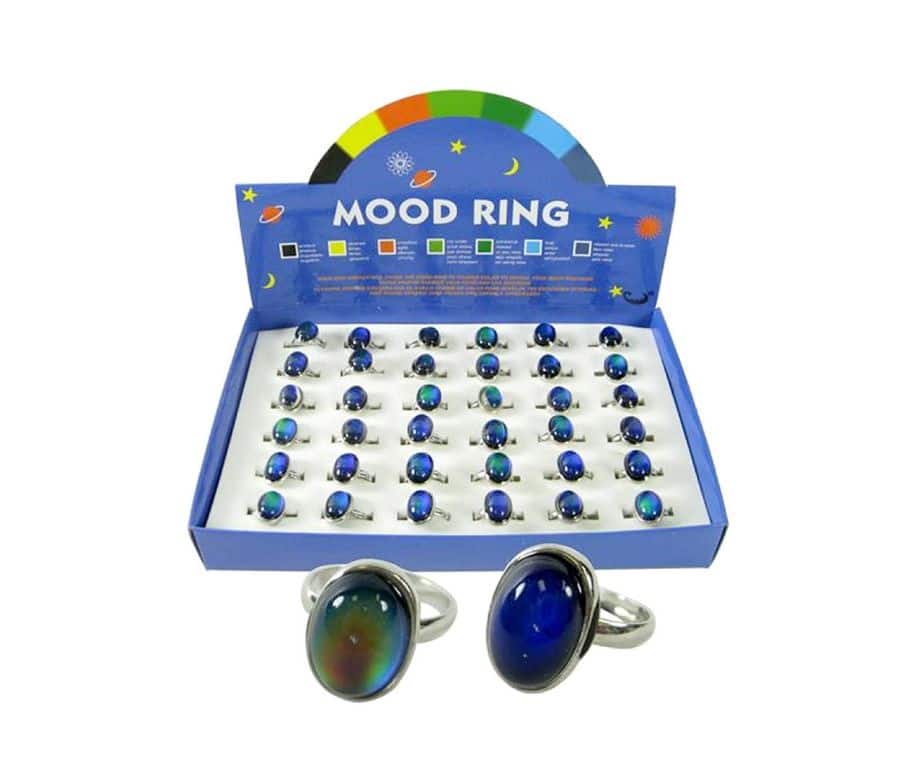Mood rings first became popular in the 1970s and have seen a resurgence in recent years. These rings change colors based on your body temperature to supposedly reveal your mood or emotional state. But how do mood rings actually work and what do the different colors indicate?
How Mood Rings Work
Mood rings contain thermochromic liquid crystals that are heat-sensitive and change colors based on the temperature of your skin. The ring is made of metal (such as stainless steel) that conducts body heat from your finger to the liquid crystals inside the stone or glass shell on top. When your finger temperature changes, it alters the molecular structure of the liquid crystals, causing them to reflect different wavelengths of light that we see as different colors.
There is no real scientific proof that mood rings can accurately reflect your emotions. However, your finger temperature does fluctuate slightly with your moods and stress levels. So the color changes in a mood ring are more just for fun than providing insight into your actual emotional state.
Mood Ring Color Meanings
While mood ring colors may not truly reveal your inner psyche, most rings tend to follow a similar color guide. Here are the most common mood ring color meanings:
| Color | Meaning |
|---|---|
| Black | Tense, stressed |
| Blue | Calm, relaxed |
| Green | Normal, average mood |
| Yellow | Anxious, excited |
| Brown | Nervous, distressed |
| Grey | Sad, depressed |
| Purple | Passionate, loving |
| Red | Happy, affectionate |
As you can see, cool colors like blue and green represent more calm, relaxed states while warm colors like red and yellow indicate excited, passionate moods. Keep in mind that each ring will have slightly different color variations and interpretations.
What Impacts Mood Ring Colors?
Several factors can influence your body temperature and cause mood ring colors to change, including:
- Emotions – Feeling stressed or anxious can raise your temperature, resulting in warmer colors. While feeling relaxed or sad can lower it, causing cooler colors.
- Physical Activity – Exercise and movement raises your temperature, while resting will lower it.
- External Temperature – Hot or cold environments will impact your skin temperature.
- Blood Flow – Increased blood circulation to your fingers will warm them.
- Illness – Fevers or sickness generally increase body heat.
So while mood ring colors don’t necessarily reflect your emotions, they are responding to shifts in your physical temperature. But it’s normal for the color to change throughout the day based on what you are doing and feeling as well as the environment you are in.
Choosing a Quality Mood Ring
For the most accurate and sensitive color responses, look for a high quality mood ring made with:
- Pure thermochromic liquid crystals – Avoid rings with powdered crystals that deteriorate over time.
- Durable, high-conductive metal – Silver, stainless steel and copper work best.
- Smooth, flat bottom – Ensures even contact with your skin to measure temperature.
- Thin band – Minimizes temperature loss before reaching the stone.
- Encased stone – Prevents exposure to elements that may impact the crystals.
Avoid cheap novelty rings with uneven or plastic bottoms as they will be less reactive to small temperature changes. While mood rings can be fun fashion accessories, higher quality rings will provide the most vibrant, accurate color responses.
Caring for Your Mood Ring
Taking proper care of your mood ring will help preserve the brilliance of the liquid crystals and accuracy of the color responses. Here are some tips:
- Avoid extreme temperatures – Don’t leave in hot cars or freeze. Keep between 60-80°F.
- Protect from sunlight – UV rays and excessive light can damage the crystals.
- Remove during activities – Take off when washing hands, exercising, etc. to prevent scratches and dings.
- Clean with soft cloth – Use a damp, soft microfiber cloth to remove dirt and oils.
- Don’t submerge in water – Moisture can seep into the stone and cause fogginess.
- Store in soft pouch – Place inside a ring box or soft bag when not wearing.
With proper use and care, a high quality mood ring should maintain accuracy and provide years of entertaining color changes!
Conclusion
While mood rings don’t actually reveal your emotional inner state, they can be fun jewelry accessories that respond to shifts in your physical temperature. The colors are meant as loose interpretations only based on common associations. But it can be enjoyable to observe how your activities, environment and health influence the ring’s changing hues throughout the day. With quality construction and proper handling, mood rings can provide years of colorful entertainment and conversation.


